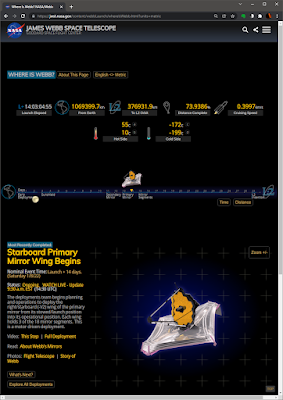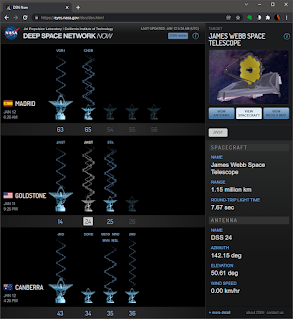While hand grinding the coffee beans, I took in the snow crystals outside reflecting sunlight. Like tiny prisms bending light, they flickered white, yellow, red, and blue.
It was another cold day in south-western Ontario with an air temperature of -15° Celsius.
Let's switch to Kelvin, yeah. Feels so much warmer! It's a balmy 258°K.
(And for those still trapped in the 1980s, that's 5° Fahrenheit. Gettin' down to where C and F align...)
Dark roast beans coarsely ground, I fired up the machine. Mmm. Coffee!
§
Back on 16 January, I enjoyed a similar morning. The Sun's light slipped through the bows of eastern evergreens and reflected off the snow making bright points of light. The snowflakes, like pieces of glass tossed, diverted beams of light into my eyes. They were little mirrors those tiny hexagons.
I thought of the eighteen hexagons heading from Earth to the Lagrange point number 2 (L2). I thought of the James Webb Space Telescope (JWST) and its beryllium gold-coated mirror segments drifting through cold dark space.
The new telescope by NASA in the US with contributions from the European and Canadian space agencies launched on Christmas morning, a gift to scientists and researchers around the world.
I watched the launch on 25 Dec 2021 at 6:30 AM. While there wasn't much to see, it was thrilling. And it went without a hitch. Rocket launches ain't easy and there's always a degree of risk but the Ariane 5 launcher has a great track record and it performed flawlessly.
I think everyone started to breathe again when it reached orbit and deployed it's solar array.
Still. Lots to remain anxious about. These were the first 49 milestones of the 344 single-point failures. Ugh.
Nevertheless, I was happy and relieved. All the extraordinary work and effort and planning. All the great care that went into building this new deep space telescope. They had to take the time. They had to be perfect. And it was all starting to pay off.
Exciting! Exciting stuff. For space nerds.
I had to be quiet, in the early morning, as Mom slept. Alone, I made a silent Woo Hoo!
§
Some time later I noted Dr Becky's YouTube video, ugly Christmas sweater and all.
She was so funny.
Kid in a candy shop.
Science nerds getting excited!
§
I started monitoring the JWST page at NASA. It has lots of great content. I was particularly interested in the interactive tracker (Metric version linked) and I tuned in daily, some times a few times each day.
The snapshot above shows the progress on 8 Jan. I would flip between the distance and time scales. I watched the temperatures drop on the "cold side" of the telescope.
Another big moment was the unfurling of the multi-layer shield. A lot could have gone wrong here but the aluminium-coated Kapton diamonds deployed perfectly. The five sheets, each less than 0.1mm thick, would deflect the Sun's energy. Whew!
Full deployment was another celebratory moment. And then I monitored the unlocking of the mirror segments starting on 12 Jan. The individual hexagonal parts, each 1.3 metres across, edge to edge, elevated correctly over the coming week. Her wings stretched.
§
I totally forgot to look at the DSN page after the launch. That would have been fun. But I jumped in later and saw the new data feed.
The snap is from the Deep Space Network web site on 22 Jan.
Hailing frequencies open.
§
I started reading the blog every other day or so. It's good for keeping up to date.
§
The pop-ups in my Android's Chrome were wonky and annoying. Lots of sources, who don't know what they are talking about, touted the telescope beginning to image stars. No. Not really. It's calibrating. It's in the commissioning phase. Hold your horses.
Tuned in to Dr Becky again on 11 Feb.
She talked about the first image, showing the fragmented blobs, a star broken and scattered, as the mirror segments were being calibrated and aligned. This will be a long and careful process which will result in a single focused star, with a resolution down to 0.1 seconds-of-arc.
This is the "naff" image Dr Smethurst's on about:
NASA continues to change the angles of the hexagons, collecting and directing photons from light-years away. Like when amateurs collimate their mirrors and correctors.
Today I popped back into the JWST web site. Hadn't looked for a while. Oooh. Look at that!
Those temperatures look good.
Some of the instruments need to operate at 50°K. So we're getting there. Almost as cold as Ontario!
Such an amazing accomplishment. Everything is working very well.
I'll have to segue to this in future project management training courses I deliver. The JWST team had to be perfect. Absolutely perfect.
§
I visited Sandra J's blog. About a year ago she talked about the science of snow sparkles and shared some lovely photographs.
Tiny frozen hexagons bouncing colourful beams of photons into her camera.
Ain't science beautiful?







No comments:
Post a Comment